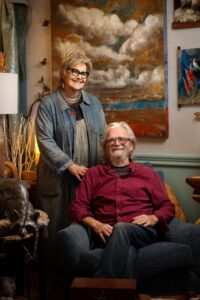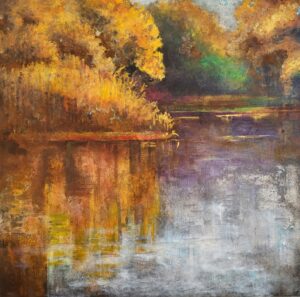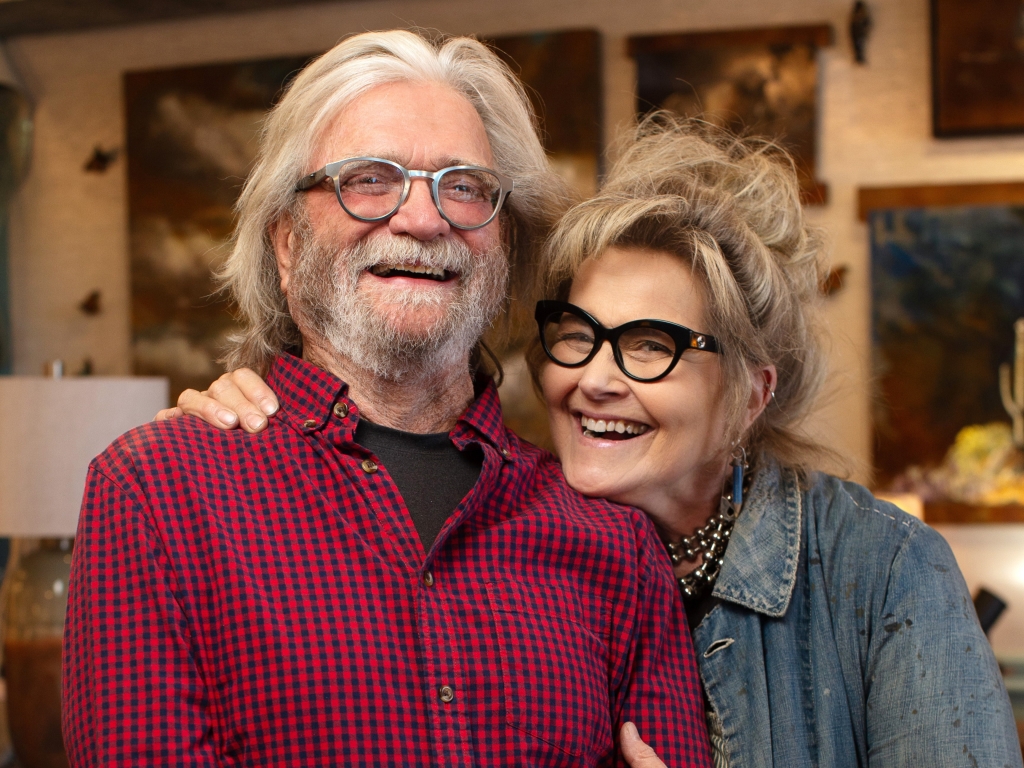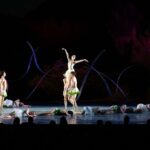Writer Rebecca L. Rhoades // Photo by Loralei Lazurek



From the street, the small Tudor-style house in Phoenix’s historic Willo District looks like an average family home. But hidden behind this nondescript facade is a world of creativity. The expansive backyard is a maze of workspaces and studios, all bursting with colorful canvases; fantastical ceramic figures and hanging assemblies; and stacks of metal, glass and clay pieces waiting to be combined into eye-catching works of art.
This is the home of husband-and-wife duo Joe Axton and Mari Giddings. Here, the artists create paintings, sculptures and mixed-media works, sometimes individually, oftentimes together. It’s a unique relationship in an imaginative field where competitiveness and egos often collide. But Giddings and Axton work in synergy, with each one’s individual skills complementing the other’s as much as their personalities and temperaments do, as well. As they chat, they good-naturedly poke fun at one another and frequently finish each other’s sentences — two artistic souls that combine into one, in life and in art.
“She’s the art department,” Axton says of his wife. “She creates things, she has ideas. And I’m the scene designer. It takes ideas to set the scene, and then I solve the problems and make it work. I think we balance each other like that.”



Strengthening Artistic Creativity
Giddings started her career as a printmaking major at Arizona State University and later worked as a monoprinter. (Monoprinting is a method of printmaking that produces a single print.) Axton got started as a scene designer and stage painter.
“In college, I wanted to be an artist with a job,” Giddings recalls. “My brother worked in an advertising agency in Manhattan, and they hired a lithographer, and I thought, ‘Wow, this guy’s making a living doing this.’ I wanted to do that, too.”
In addition to working in the theater, Axton did graphic design for newspapers and even went to graduate school in New York City, where he studied to be an essayist.
“After I met Mari during school, she would help me with scene painting for shows I was doing, and then I helped her as my side gig while I was going to graduate school,” Axton says.
Until 2008, the couple worked strictly on paper and canvas. Unframed, unstretched pieces would be rolled up and shipped to galleries and clients across the country. And while both artists still paint today, their aesthetic focuses more on color and mood than on defined shapes.
Large landscapes and abstract scenes, rendered in acrylics, are coated with metal leaf and distressed with acids and alcohol. The look is weathered and worn, with washes of pigment and overlays of texture that create a softness and dimension in the images.
“I paint with very sheer veils and in transparent layers, and then I’ll get it all beautiful and put this metal on it,” Giddings explains. “I use iron filings, silver leaf, aluminum leaf, gold leaf, copper leaf. Then I’ll come back with the acids or sand it back and just keep building.”
Rusted reds, copper greens, burnished bronze and hints of turquoise and lichen greens are brought to life with scratch marks, acid-etched splatters, and rubbed and sanded edges.



Fusion Art
These days, the couple is best known for their mixed-media work.
Giddings started working with ceramics when their kids were in preschool. She started teaching them how to hand-build items, and as they grew, she progressed to using a wheel.
“Once I got into the wheel, I got into all the tools again, and I loved it,” she recalls.
Soon, she began pairing her ceramics with metal and glass elements, building on work the couple created that featured glass, metal and clay on wood panels and set in custom metal frames designed by Axton. Known as “suspensions,” the pieces are long groupings of clay and metal, often in alternating and intersecting rings. They’re meant to hang.
“We were looking for a different way to present her ceramics,” Axton says. “We’ve done some of these as long as 10 feet.”
Giddings makes the ceramic pieces, while Axton forges the metal rings, squares and other shapes and connects them all together. She also creates totem-like structures, stacking round ceramic layers and topping them with animal-shaped heads. Chunky metal chains, keys, rings and even padlocks add visual interest. Axton ensures that the pieces remain upright.
“I’m not a very good welder, but I’m don’t have to build bridges,” Axton says. “I’m a designer who can stick stuff together with metal. If Mari envisions a structure that’s mostly ceramic, I can figure out how to make it stand up. And it could include using metal, plastic, wood.”
Like their paintings, the assemblies and sculptures are distressed. The metal is rusted, and the ceramic is painted to resemble patinated metal.
“It’s taken me years to get that look,” Giddings says. “I worked and worked and worked on getting it to look like metal. But I get so many guys who come around and think the whole thing is made of steel.
“I love to work with fire and acid and metal and decay. Everything I do is fired and rotten and decayed.”
Sue Bickerdyke, owner of Sue Bickerdyke Interiors, Home Furnishings and Art Gallery, recently added the pair’s work to her gallery in Carefree.
“I love how their art complements the work we already have,” Bickerdyke explains. “It can easily mix into a client’s home. And that’s how most people probably do it — they display pieces from a lot of different artists.”
For more than a decade, Giddens and Axton have shown their work only at art shows and Scottsdale’s annual Celebration of Fine Art invitational.
“We’re excited to have someone represent us again,” Axton says. “Sue has a great relationship with her clients, and I think we can fit into that triangle in a way that will be pleasing for everybody and fun for us.”
The couple’s art harmonizes with the Southwest-inspired decor and textural elements in Bickerdyke’s storefront.
“They’re building layers, creating dimension,” the interior designer says. “There’s a natural element, an organic feel that just seems like the right fit for the Sonoran Desert. Plus, Joe and Mari are just amazing people. It’s important to me that the artists I work with leave their energy in a way that’s compatible with our business. And Joe and Mari are so nice to each other, and they radiate love for each other. It’s cool how they love their life and their life together. And they love doing what they do.”







Comments by Admin